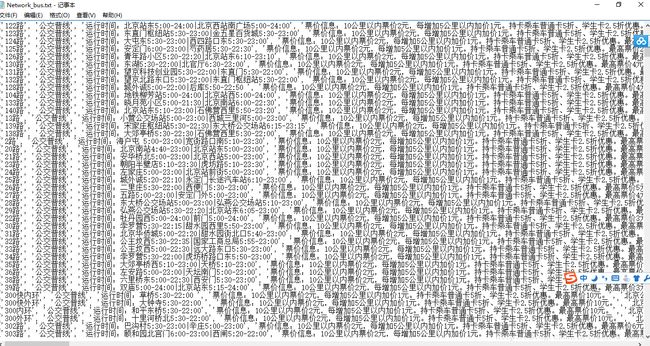Python爬虫(一)--城市公交网络站点数据的爬取
作者:WenWu_Both
出处:http://blog.csdn.net/wenwu_both/article/
版权:本文版权归作者和CSDN博客共有
转载:欢迎转载,但未经作者同意,必须保留此段声 必须在文章中给出原文链接;否则必究法律责任
爬取的站点:http://beijing.8684.cn/
(1)环境配置,直接上代码:
# -*- coding: utf-8 -*-
import requests ##导入requests
from bs4 import BeautifulSoup ##导入bs4中的BeautifulSoup
import os
headers = {'User-Agent':'Mozilla/5.0 (Windows NT 10.0; WOW64) AppleWebKit/537.36 (KHTML, like Gecko) Chrome/49.0.2623.221 Safari/537.36 SE 2.X MetaSr 1.0'}
all_url = 'http://beijing.8684.cn' ##开始的URL地址
start_html = requests.get(all_url, headers=headers)
#print (start_html.text)
Soup = BeautifulSoup(start_html.text, 'lxml') # 以lxml的方式解析html文档(2)爬取站点分析
1、北京市公交线路分类方式有3种: 代码: all_a = Soup.find(‘div’,class_=’bus_kt_r1’).find_all(‘a’) 2、接着往下,发现每1路的链接都在 3、打开线路链接,就可以看到具体的站点信息了,打开页面分析文档结构后发现:线路的基本信息存放在 自此,我们就把一条线路的相关信息及上、下行站点信息就都解析出来了。如果想要爬取全市的公交网络站点,只需要加入循环就可以了。 最后输出整个城市的公交网络站点信息,这次就先保存在txt文件里吧,也可以保存到数据库里,比如mysql或者MongoDB里,这里我就不写了,有兴趣的可以试一下,附上程序运行后的结果图:

本文通过数字开头来进行爬取,“F12”启动开发者工具,点击“Elements”,点击“1”,可以发现链接保存在
的里面,取出里面的herf即为线路网址,其内容即为线路名称,代码:
href = a['href'] #取出a标签的href 属性
html = all_url + href
second_html = requests.get(html,headers=headers)
#print (second_html.text)
Soup2 = BeautifulSoup(second_html.text, 'lxml')
all_a2 = Soup2.find('div',class_='cc_content').find_all('div')[-1].find_all('a') # 既有id又有class的div不知道为啥取不出来,只好迂回取了

title1 = a2.get_text() #取出a1标签的文本
href1 = a2['href'] #取出a标签的href 属性
#print (title1,href1)
html_bus = all_url + href1 # 构建线路站点url
thrid_html = requests.get(html_bus,headers=headers)
Soup3 = BeautifulSoup(thrid_html.text, 'lxml')
bus_name = Soup3.find('div',class_='bus_i_t1').find('h1').get_text() # 提取线路名
bus_type = Soup3.find('div',class_='bus_i_t1').find('a').get_text() # 提取线路属性
bus_time = Soup3.find_all('p',class_='bus_i_t4')[0].get_text() # 运行时间
bus_cost = Soup3.find_all('p',class_='bus_i_t4')[1].get_text() # 票价
bus_company = Soup3.find_all('p',class_='bus_i_t4')[2].find('a').get_text() # 公交公司
bus_update = Soup3.find_all('p',class_='bus_i_t4')[3].get_text() # 更新时间
bus_label = Soup3.find('div',class_='bus_label')
if bus_label:
bus_length = bus_label.get_text() # 线路里程
else:
bus_length = []
#print (bus_name,bus_type,bus_time,bus_cost,bus_company,bus_update)
all_line = Soup3.find_all('div',class_='bus_line_top') # 线路简介
all_site = Soup3.find_all('div',class_='bus_line_site')# 公交站点
line_x = all_line[0].find('div',class_='bus_line_txt').get_text()[:-9]+all_line[0].find_all('span')[-1].get_text()
sites_x = all_site[0].find_all('a')
sites_x_list = [] # 上行线路站点
for site_x in sites_x:
sites_x_list.append(site_x.get_text())
line_num = len(all_line)
if line_num==2: # 如果存在环线,也返回两个list,只是其中一个为空
line_y = all_line[1].find('div',class_='bus_line_txt').get_text()[:-9]+all_line[1].find_all('span')[-1].get_text()
sites_y = all_site[1].find_all('a')
sites_y_list = [] # 下行线路站点
for site_y in sites_y:
sites_y_list.append(site_y.get_text())
else:
line_y,sites_y_list=[],[]
information = [bus_name,bus_type,bus_time,bus_cost,bus_company,bus_update,bus_length,line_x,sites_x_list,line_y,sites_y_list]
完整代码:# -*- coding: utf-8 -*-
# Python3.5
import requests ##导入requests
from bs4 import BeautifulSoup ##导入bs4中的BeautifulSoup
import os
headers = {'User-Agent':'Mozilla/5.0 (Windows NT 10.0; WOW64) AppleWebKit/537.36 (KHTML, like Gecko) Chrome/49.0.2623.221 Safari/537.36 SE 2.X MetaSr 1.0'}
all_url = 'http://beijing.8684.cn' ##开始的URL地址
start_html = requests.get(all_url, headers=headers)
#print (start_html.text)
Soup = BeautifulSoup(start_html.text, 'lxml')
all_a = Soup.find('div',class_='bus_kt_r1').find_all('a')
Network_list = []
for a in all_a:
href = a['href'] #取出a标签的href 属性
html = all_url + href
second_html = requests.get(html,headers=headers)
#print (second_html.text)
Soup2 = BeautifulSoup(second_html.text, 'lxml')
all_a2 = Soup2.find('div',class_='cc_content').find_all('div')[-1].find_all('a') # 既有id又有class的div不知道为啥取不出来,只好迂回取了
for a2 in all_a2:
title1 = a2.get_text() #取出a1标签的文本
href1 = a2['href'] #取出a标签的href 属性
#print (title1,href1)
html_bus = all_url + href1
thrid_html = requests.get(html_bus,headers=headers)
Soup3 = BeautifulSoup(thrid_html.text, 'lxml')
bus_name = Soup3.find('div',class_='bus_i_t1').find('h1').get_text()
bus_type = Soup3.find('div',class_='bus_i_t1').find('a').get_text()
bus_time = Soup3.find_all('p',class_='bus_i_t4')[0].get_text()
bus_cost = Soup3.find_all('p',class_='bus_i_t4')[1].get_text()
bus_company = Soup3.find_all('p',class_='bus_i_t4')[2].find('a').get_text()
bus_update = Soup3.find_all('p',class_='bus_i_t4')[3].get_text()
bus_label = Soup3.find('div',class_='bus_label')
if bus_label:
bus_length = bus_label.get_text()
else:
bus_length = []
#print (bus_name,bus_type,bus_time,bus_cost,bus_company,bus_update)
all_line = Soup3.find_all('div',class_='bus_line_top')
all_site = Soup3.find_all('div',class_='bus_line_site')
line_x = all_line[0].find('div',class_='bus_line_txt').get_text()[:-9]+all_line[0].find_all('span')[-1].get_text()
sites_x = all_site[0].find_all('a')
sites_x_list = []
for site_x in sites_x:
sites_x_list.append(site_x.get_text())
line_num = len(all_line)
if line_num==2: # 如果存在环线,也返回两个list,只是其中一个为空
line_y = all_line[1].find('div',class_='bus_line_txt').get_text()[:-9]+all_line[1].find_all('span')[-1].get_text()
sites_y = all_site[1].find_all('a')
sites_y_list = []
for site_y in sites_y:
sites_y_list.append(site_y.get_text())
else:
line_y,sites_y_list=[],[]
information = [bus_name,bus_type,bus_time,bus_cost,bus_company,bus_update,bus_length,line_x,sites_x_list,line_y,sites_y_list]
Network_list.append(information)
# 定义保存函数,将运算结果保存为txt文件
def text_save(content,filename,mode='a'):
# Try to save a list variable in txt file.
file = open(filename,mode)
for i in range(len(content)):
file.write(str(content[i])+'\n')
file.close()
# 输出处理后的数据
text_save(Network_list,'Network_bus.txt');


